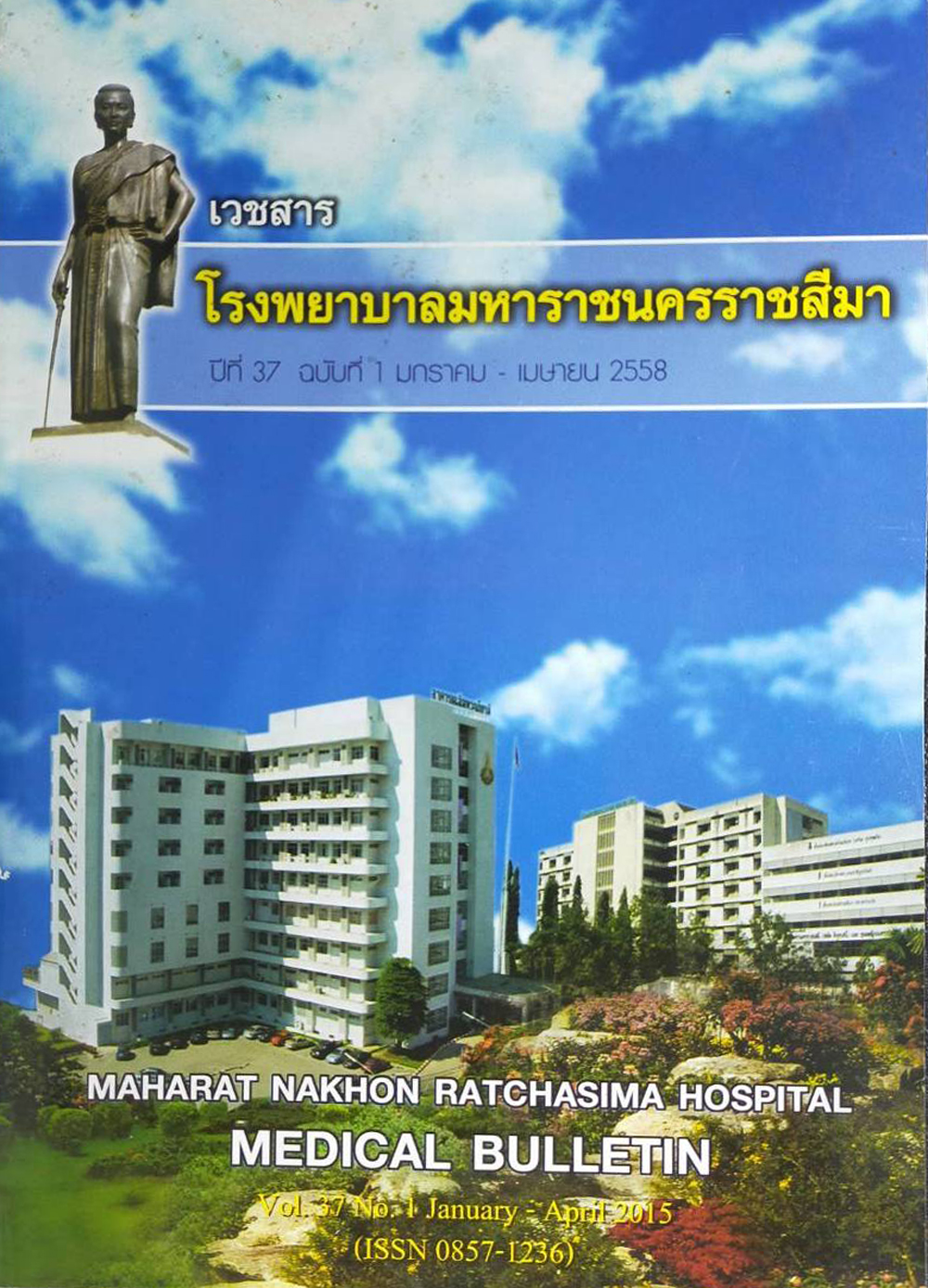ความชุกและปัจจัยที่เกี่ยวข้องกับการได้รับยารักษาอาการทางจิตประสาท ในผู้ป่วยภาวะสมองเสื่อมที่มีอาการทางจิตประสาท
Main Article Content
บทคัดย่อ
ภูมิหลัง: อาการทางจิตประสารทเป็น อาการที่พบได้บ่อยในผู้ป่วยภาวะสมองเสื่อม โดยทั่วไปจะรักษาโดยวิธีการปรับสภาพแวดล้อมและพฤติกรรมก่อน แต่ในผู้ป่วยบางรายการควบคุมอาการเหล่านี้ด้วยยากลุ่ม psychotropic drug(PD) ยังมีความจำเป็น วัตถุประสงค์: ศึกษาหาความชุกของผู้ป่วยภาวะสมองเสื่อมที่มีอาการทางจิตประสาทที่ได้รับการรักษาด้วยยา PD และปัจจัยที่เกี่ยวข้องกับการได้รับยา ณ คลินิกความจำ โรงพยาบาลมหาราชนครราชสีมาผู้ป่วยและวิธีการ: เป็นการวิจัยแบบภาคตัดขวางในผู้ป่วยภาวะสมองเสื่อมที่มีอาการทางจิตประสาท ณ คลินิกความจำ โรงพยาบาลมหาราชนครราชสีมา ระหว่างเดือนมกราคมถึงมิถุนายน พ.ศ. 2556 โดยประเมินอาการทางจิตประสาท ด้วยแบบทดสอบอาการทางจิตประสาท (Neuropsychiatric Inventory-NPI) แล้วเก็บข้อมูลพื้นฐานของผู้ป่วย รวมถึงจำนวนและชนิดของยา PD ที่ได้รับ (ยาระงับอาการทางจิต ยาควบคุมอารมณ์ ยาต้านอาการซึมเศร้าและยานอนหลับ) ข้อมูลทั้งหมดจะถูกนำมาวิเคราะห์เพื่อหาความชุกและปัจจัยที่เกี่ยวข้องกับการได้รับยา PDในผู้ป่วยภาวะสมองเสื่อมที่มีอาการทางจิตประสาท ผลการศึกษา: มีผู้ป่วยภาวะสมองเสื่อมที่มีอาการทางจิตประสาทจำนวน 65 รายเข้าร่วมการศึกษา มีอายุเฉลี่ย 73.9+8.1 ปี เป็นสมองเสื่อมชนิดอัลไซม์เมอร์ร้อยละ 47.7 ผู้ป่วยร้อยละ 53.8 ได้รับยา PD รักษาอาการทางจิตประสาท โดยยากลุ่ม antipsychotics เป็นยาที่ใช้มากที่สุด (ร้อยละ30.8) รองลงมาได้แก่กลุ่มยานอนหลับ (ร้อยละ 16.9) โดยปัจจัยที่เกี่ยวกับการได้รับยา PD ได้แก่ ผู้ป่วยสูงอายุผู้ป่วยที่ความเสื่อมของระดับเชาว์ปัญญามากและผู้ป่วยที่มีจำนวนอาการทางจิตประสาทหลายอาการ สรุป:ความชุกของผู้ป่วยภาวะสมองเสื่อมที่มีอาการทางจิตประสาทและได้รับยา PD ณ คลินิกความจำ โรงพยาบาลมหาราชนครราชสีมา เท่ากับร้อยละ 53.8 โดยปัจจัยที่เกี่ยวข้องกับการได้รับยาได้แก่ ผู้ป่วยสูงอายุ ผู้ป่วยที่ความเสื่อมของระดับเชาว์ปัญญามากและผู้ป่วยที่มีจำนวนอาการทางจิตประสาทหลายอาการ
Article Details

อนุญาตภายใต้เงื่อนไข Creative Commons Attribution-NonCommercial-NoDerivatives 4.0 International License.
เอกสารอ้างอิง
Jitapunkul S, Kunanusont C, Phoolcharoen W, Suriyawongpaisal P. Prevalence estimation of dementia among Thai elderly: a national survey. J Med Assoc Thai 2001; 84: 461-7.
Rubin EH, Kinscherf DA. Psychopathology of very mild dementia of the Alzheimer type. Am J Psychiatry 1989; 146: 1017-21.
Stern Y, Tang MX, Albert MS, Brandt J, Jacobs DM, Bell K, et al. Predicting time to nursing home care and death in individuals with Alzheimer disease. JAMA 1997; 277: 806-12.
Mekawichai P. Prevalence of neuropsychiatric symptoms in dementia and their associated factors: A cross-sectional study. I-san J of Intern Med 2013; 4: 23-31.
Gonzแlez-Salvador T, Lyketsos CG, Baker A, Hovanec L, Roques C, Brandt J, et al. Quality of life in dementia patients in long-term care. Int J Geriatr Psychiatry 2000; 15: 181-9.
Psychiatry Association. Diagnostic and statistical manual of mental disorders text revised. (DSM-IV-TR) 4th edition. Washington (DC): American psychiatric Press; 2000.
Cummings JL, Mega M, Gray K, Rosenberg-Thompson S, Carusi DA, Gornbein J. The Neuropsychiatric Inventory: comprehensive assessment of psychopathology in dementia. Neurology 1994; 44: 2308-14.
Train the Brain Forum Committee. Thai Mental State Examination (TMSE). Siriraj Hosp Gaz 1993; 45: 359-74.
Schneider LS, Dagerman KS, Insel P. Risk of death with atypical antipsychotic drug treatment for dementia: meta-analysis of randomized placebocontrolled trials. JAMA 2005; 294: 1934-43.
Kales HC, Kim HM, Zivin K, Valenstein M, Seyfried LS, Chiang C, et al. Risk of mortality among individual antipsychotics in patients with dementia. Am J Psychiatry 2012; 169: 71-9.
Piersanti M, Capannolo M, Turchetti M, Serroni N, De Berardis D, Evangelista P, et al. Increase in mortality rate in patients with dementia treated with atypical anti-psychotics: a cohort study in outpatients in Central Italy. Riv Psichiatr. 2014; 49: 34-40.
Nijk RM, Zuidema SU, Koopmans RT. Prevalence and correlates of psychotropic drug use in Dutch nursing-home patients with dementia. Int Psychogeriatr 2009; 21: 485-93.
Kim H, Whall AL. Factors associated with psychotropic drug usage among nursing home residents with dementia. Nurs Res 2006; 55: 252-8.
Petek SM, Cedilnik GE. Psychotropic medication use among elderly nursing home residents in Slovenia: cross-sectional study. Croat Med J 2011; 52: 16-24.
Barnes TR, Banerjee S, Collins N, Treloar A, McIntyre SM, Paton C, et al. Antipsychotics in dementia: prevalence and quality of antipsychotic drug prescribing in UK mental health services. Br J Psychiatry 2012; 201: 221-6.
Weintraub D, Chen P, Ignacio RV, Mamikonyan E, Kales HC. Patterns and trends in antipsychotic prescribing for Parkinson disease psychosis. Arch Neurol 2011; 68: 899-904.
Frenchman IB. Atypical antipsychotics for nursing home patients: a retrospective chart review. Drug Aging 2005; 22: 257-64.
Sultzer DL, Davis SM, Tariot PN, Dagerman KS, Lebowitz BD, Lyketsos CG, Clinical symptom responses to atypical antipsychotic medications in Alzheimer’s dis ease: phase 1 outcomes from the CATIE-AD effectiv ness trial. AM J Psychiatry 2008; 165: 844-54.
Monette J, Alessa W, McCusker J, Cole M, Voyer P, Champoux N, et al. Association of resident and room characteristics with antipsychotic use in long-term care facilities (LTCF). Arch Gerontol Geriatr 2012; 55: 66-9.
Kleijer BC, van Marum RJ, Frijters DH, Jansen PA, Ribbe MW, Egberts AC, et al. Variability between nursing homes in prevalence of antipsychotic use in patients with dementia. Int Psychogeriatr 2014; 26: 363-71.
Zuidema SU, de Jonghe JF, Verhey FR, Koopmans RT. Psychotropic drug prescription in nursing home patients with dementia: influence of environmental correlates and staff distress on physicians’ prescription behavior. Int Psychogeriatr 2011; 23: 1632-9.

